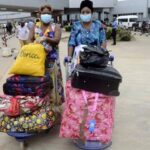Mulago National Referral Hospital is on the brink of a healthcare disaster as the recent withdrawal of U.S. aid funding has left the facility overwhelmed, under-resourced, and severely understaffed. The abrupt cut in financial support, which primarily affected HIV/AIDS programs, has forced thousands of patients to seek treatment at Mulago, adding enormous pressure to an already overstretched public health system.
Dr. Rosemary Byanyima, Executive Director of the hospital, raised the alarm during a presentation to Parliament’s Health Committee on April 2, 2025, while discussing the institution’s policy and budgetary needs for the 2025/26 fiscal year. She disclosed that the hospital is currently operating with only 67% of its required personnel, yet must now cater to the influx of HIV/AIDS patients previously supported by non-governmental clinics.
“These organizations used to handle between 50 to 100 patients daily. Now, those individuals are turning to us, but we lack the human resources, space, and lab capacity to cope,” Dr. Byanyima noted. She added that without additional support, critical services such as antiretroviral therapy (ART) delivery and patient record management could collapse.

This crisis follows Health Minister Dr. Jane Ruth Aceng’s disclosure last week that Uganda had lost over UGX604 billion in health-related donor funding, the bulk of which UGX243.2 billion was tied to HIV/AIDS programs. She warned lawmakers that unless alternative financing is secured, key health services risk grinding to a halt.
While Mulago has tried to integrate HIV care into its Infectious Disease Clinic, Dr. Byanyima cautioned that the facility lacks the infrastructure to manage increased drug supply chains and ensure consistent patient care. Vulnerable populations such as sex workers, previously supported under targeted outreach programs like the Most At-Risk Population Initiative (MAPI), are now facing diminished services.
“MAPI used to provide specialized care for sex workers in our STD clinic. If we don’t support this group effectively, we could see a resurgence in HIV transmission,” she warned.
Beyond the HIV care challenge, the hospital is also facing a critical shortage of medical supplies. In the upcoming fiscal year, it has only been allocated UGX17.756 billion far below the UGX101 billion required to adequately stock its shelves. Lawmakers were shocked to learn that the Uganda Revenue Authority received more funds for medicine for its staff than Mulago was allocated for the entire national referral system.
“We’re introducing advanced medical services, but patients are often told to buy essential items from private vendors,” Dr. Byanyima revealed. She called for an additional UGX43.5 billion to enable recruitment of vital health workers, especially for the Intensive Care Unit (ICU), which remains underutilized due to wage budget constraints.
Dr. Byanyima also highlighted urgent needs for equipment servicing, citing a recent UGX3.5 billion expenditure to repair a broken MRI machine as an example of what can happen when maintenance is neglected. She urged Parliament to increase the maintenance budget to at least UGX13 billion.
Meanwhile, Mulago Specialized Women and Neonatal Hospital is also feeling the pinch. Its Executive Director, Dr. Evelyn Nabunya, told the committee that the hospital is in dire need of staff to operate its seven dormant theatres and ease the burden in the Neonatal Intensive Care Unit (NICU), where nurse-to-patient ratios are dangerously high.
“One nurse is currently caring for up to 15 newborns. That’s not sustainable,” she stressed. The hospital is requesting UGX4 billion to recruit 86 healthcare professionals, including anesthesiologists and neonatal specialists.
Additionally, the women’s hospital is seeking UGX2.9 billion to maintain high-tech equipment needed for fertility treatments, including IVF. Each IVF cycle costs UGX13.35 million, and the facility hopes to serve 100 women in the coming financial year.
As the funding vacuum deepens, both hospital heads warned that unless urgent steps are taken, Uganda’s flagship health facilities may soon be unable to meet even the most basic demands of patient care.




























